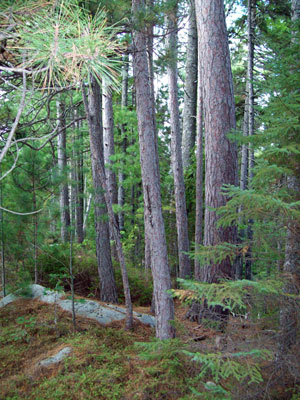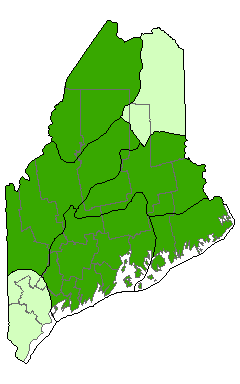DACF Home → Bureaus & Programs → Maine Natural Areas Program → Communities, Plants, and Animals → Natural Community Fact Sheets → Red and White Pine Forest
Printer Friendly Fact Sheet - 1.1 MB pdf (Get a free copy of Adobe Acrobat Reader)
Red and White Pine Forest
Scientific Name: Red Pine - White Pine Forest; State Rank: S3

- Community Description
- Soil and Site Characteristics
- Diagnostics
- Similar Types
- Conservation, Wildlife and Management Considerations
- Distribution
- Characteristic Plants
- Associated Rare Plants
- Associated Rare Animals
- Examples on Conservation Lands You Can Visit
Community Description: These are upland forests with red pine as the dominant tree; white pine, red spruce, or, near the coast, northern white cedar may be co-dominant. The canopy may be somewhat open but is more typically >70%. Especially in post-fire sites, the canopy may include deciduous trees such as paper birch, red maple or big-toothed aspen. Lower layers are generally sparse (<25% cover) and contain few species; some sites may have scattered heath shrubs such as huckleberry, lowbush blueberry, or sheep laurel. Bracken fern and wintergreen are almost always present in the herb layer, but at low cover. Graminoids are virtually absent. The ground is typically covered with conifer litter and patches of bryophytes, or less commonly, lichens. Back to top.
Soil and Site Characteristics: Sites are usually on flats, slopes of <25% or low ridges (<1000’), on dry-mesic to xeric soils that are somewhat to very shallow (10-50 cm to obstruction, usually bedrock). Soils are coarse (sandy loams to sands) and acidic (pH 4.8-5.2). Many sites have evidence of past fires. Back to top.
Diagnostics: The forest canopy typically exceeds 65%, with red pine dominant or co-dominant (at least 33% cover) with other conifers; the shrub layer is usually sparse (<15%). Back to top.
Similar Types: Red Pine Woodlands have a more open canopy (usually <50%), a more well developed heath shrub layer (>25%), and are usually on sites with only a very thin soil layer, or merely an organic layer, over bedrock. White Pine Forests may contain red pine, but white pine is more dominant. Back to top.
Conservation, Wildlife and Management Considerations: Red pine has been widely planted in the past, but natural occurrences of this type are fairly rare outside of eastern Maine. Under natural conditions, these forests apparently require fire for persistence or regeneration, but community dynamics are not well documented, and at some known sites clearcut harvesting has perpetuated the type. Most known sites are small, lack formal protection, and could be maintained within a forested matrix.
This community type may be used as nesting habitat by a number of coniferous forest specialist bird species, such as the pine warbler and red crossbill. It may also include rare moths such as the oblique zale and the southern pine sphinx, whose larvae feed on red pine. Back to top.
Distribution: Eastern Broadleaf Forest Province and New England - Adirondack Province, extending both east and west from Maine. Landscape Pattern: Small to Large Patch. Back to top.


Characteristic Plants: These plants are frequently found in this community type. Those with an asterisk are often diagnostic of this community.
- Canopy
- Big-toothed aspen*
- Red pine*
- Red spruce*
- White pine
- Hemlock
- Sapling/shrub
- Balsam fir
- Red spruce
- Dwarf Shrub
- Black huckleberry*
- Herb
- Bracken fern
- Canada mayflower
- Starflower
- Wintergreen
- Round-leaved pyrola
- Bryoid
- Dicranum moss
- Red-stemmed moss
There are no documented rare plants associated with this natural community.
- Oblique zale
- Southern pine sphinx
- Whip-poor-will
Examples on Conservation Lands You Can Visit
| Example | County |
|---|---|
| Attean Pond at Moose River | Somerset Co. |
| East Machias River, Rocky Lake Public Lands | Washington Co. |
| Fifth Lake Stream, Duck Lake Public Lands | Hancock Co. |
| Gassabias Lake, Duck Lake Public Lands | Hancock Co. |